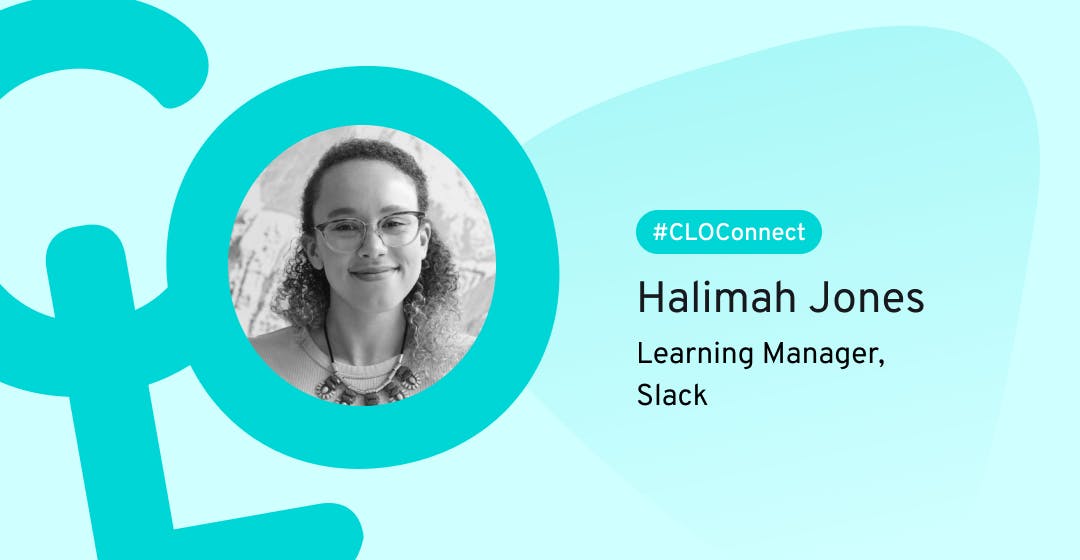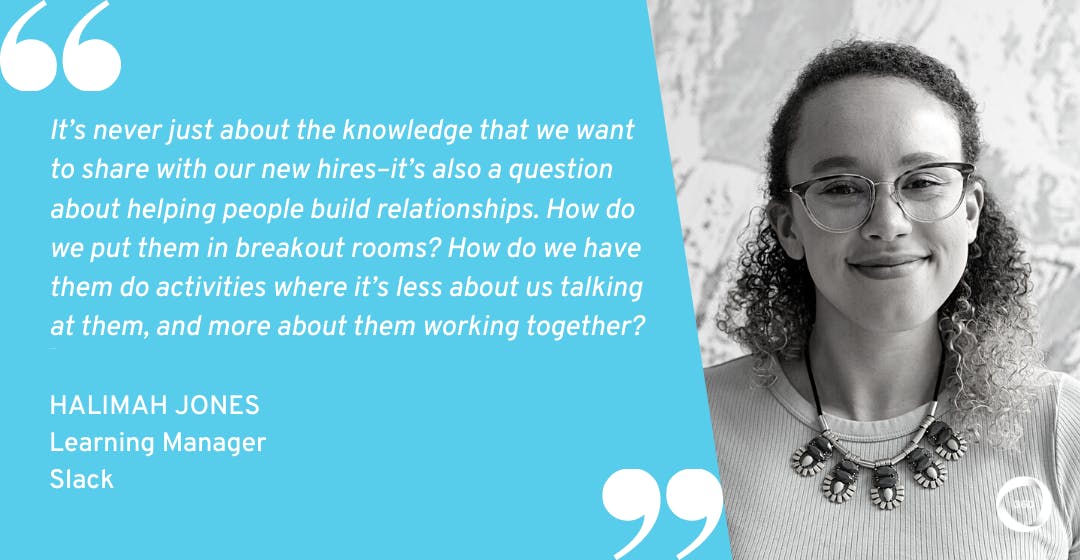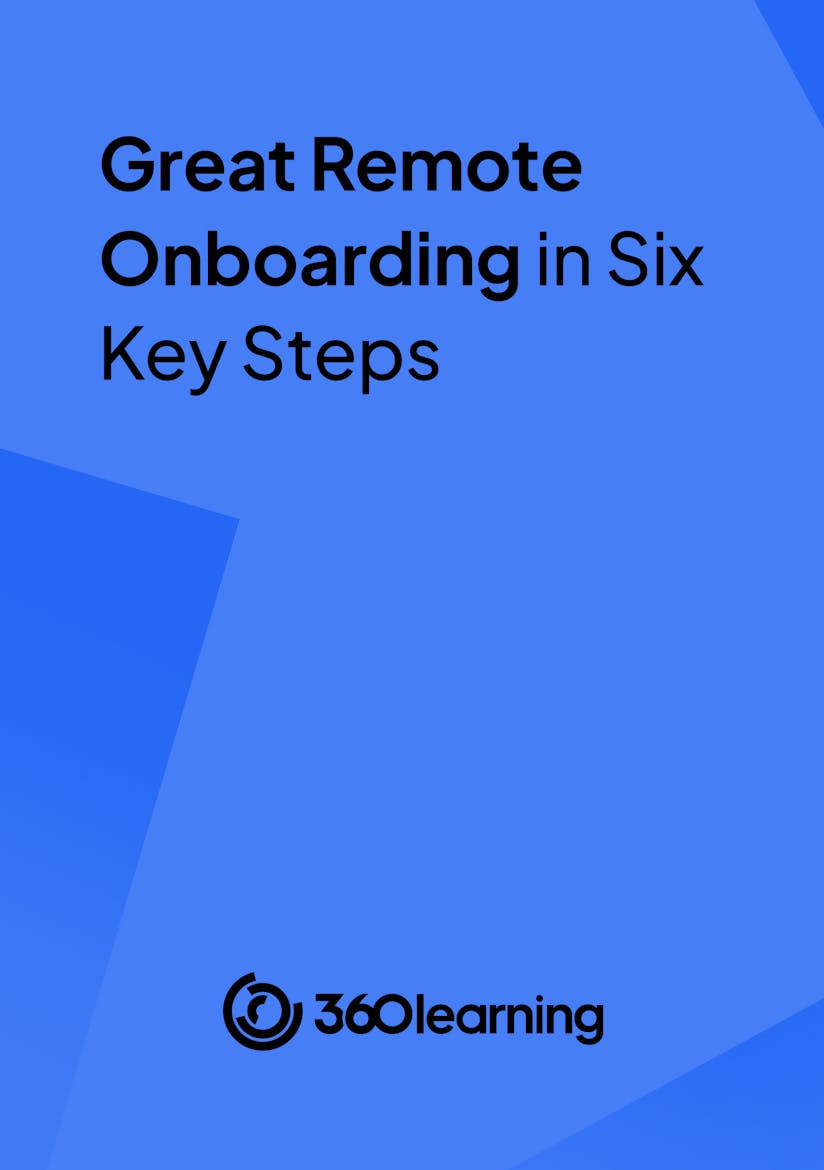
Slack’s 4-Step Playbook for Building New Hire Communities through Remote Onboarding
Every L&D leader knows how important great onboarding can be. You need to ensure that when people join your company they feel welcomed, connected, and part of the culture.
But how can L&D teams design remote onboarding programs that help new hires feel connected to their workplace community, build their relationships between teams, and be part of their company’s culture–all from a distance?
During the COVID-19 pandemic, we’ve all been looking for ways to create a feeling of new-hire belonging through remote learning experiences. That’s why my discussion with Halimah Jones, Learning Manager at Slack, about her team’s four-step playbook for building community through remote onboarding really resonated with me.
Halimah had a great deal of insight to share–read on to be inspired.
Loving what you’re reading? Come and join the L&D Collective for more great learning insights, resources, and events!
Why it’s so important to create a sense of community for new hires
All over the world, Slack is helping countless companies stay connected and get things done. But how can Slack keep its own new hires connected during a global pandemic? And how can Halimah deliver the same sense of new-hire belonging and community from a distance?
As Halimah explained, she and her team started by looking at what was working well with their existing onboarding program.
“What we really loved about our in-person onboarding program was having the global new hires coming into the office every single week, meeting new people and making cross-functional relationships. Then, people are able to use that as they start to collaborate and work together to build a sense of community.”
However, Halimah and her team had to quickly redesign their onboarding program in response to the shift to remote learning amidst the pandemic.
“We had to reimagine what the program looks like, not only for onboarding, but for other L&D programs. We had so many things that were reliant on us building a community of learners. We were also relying on each other to build the knowledge. All of this had to change as we moved into remote learning.”
So, how did Halimah and her team make this change within Slack’s onboarding program? She laid it all out in her four-step playbook.
Need a few more CLO Connect expert insights? Find out How to Build a Stronger Company Culture with L&D.

What's company culture without L&D?
By providing your contact info, you agree to receive communications from 360Learning. You can opt-out at any time. For details, refer to our Privacy Policy.
We had so many things that were reliant on us building a community of learners. We were also relying on each other to build the knowledge. All of this had to change as we moved into remote learning.
Slack’s 4-step playbook for building community through remote onboarding
For Halimah, the key goal in shifting to remote onboarding at Slack was to build community and share collective knowledge across the company.
“It’s never just about the knowledge that we want to share with our new hires–it’s also a question about helping people build relationships. How do we put them in breakout rooms? How do we have them do activities where it’s less about us talking at them, and more about them working together?”

“Now, the program is about facilitating activities, and having people self-discover the knowledge they already have. I really want to hear from everybody else at Slack during the onboarding process, especially about their different experiences and identities, because learning from other people is such a better way to learn rather than from just one person.”
As Halimah explains, she and her team use a four-step process to bring this to life. First up: introduce the L&D team.
1. Introduce the new hires to the Slack L&D team
“The biggest thing that makes our program unique is that we have a separate workspace where we can talk to new hires before they start,” says Halimah. “They can learn a little about the company, and we can try to start transitioning them away from email as quickly as possible.”
“It also helps my team a lot,” says Halimah. “We are able to triage tasks a lot faster. Information isn’t just stuck in people’s inboxes, which means we can start delegating right away.”
2. Reinforce your company’s culture and introduce essential tools
Next, Halimah and her team try to reinforce what it’s really like to work at Slack, giving their new hires all the tools they need before they join their teams–as well as a sense of the company’s unique culture.
“Once our new hires join, we set it up so that only the live sessions deal with our culture and learning our product. We were acquired by Salesforce last year, so we go through a few of Salesforce’s sessions. Then they come back to us to learn Slack 101: a tour through the company’s culture, as well as some community building.”
Halimah and her team try to include a focus on Slack’s distinctive culture within every session. “We realize that as you’re working remotely, there’s a little more investment from our new hires in joining the company and your team, rather than your department or office. The things our new hires identify with have changed drastically during this shift.”
“Knowing they’ve all gone through the ‘culture at Slack’ session for the last three plus years really gives everybody this foundational sense of our culture. Our new hires are thinking: ‘Okay, I went through this activity. I understand what it looks like to work at Slack’.”
We realize that as you’re working remotely, there’s a little more investment from our new hires in joining the company and your team, rather than your department or office.
3. Offer self-paced content to ramp-up new hires
With these steps in place, Halimah and her team can move ahead to self-paced content.
“We have a video describing the story of Slack: how we started as a video game company to where we are today,” says Halimah. “Again, we’re really focusing on not just what you need to do your job, but also how we embed some of the cultural aspects into the onboarding.”
“We want to help new hires ramp up as quickly as possible while also giving them some of those skills and knowledge that you don’t normally have on paper–it’s just a thing somebody has to tell you is a norm.”
We want to help new hires ramp up as quickly as possible while also giving them some of those skills and knowledge that you don’t normally have on paper.
4. Boost your sense of community with group activities
Finally, the L&D team uses group activities to build a stronger sense of community amongst new hires.
“The newcomers talk a lot,’ says Halimah. “We’ve built it in that they post their welcome messages from their managers in a specific channel where they get to meet each other. A lot of our sessions have breakout rooms and we have different amounts of people in each room.”
“My favorite activity is the one where they have to come up with three things and bring them into a group: one thing you’ve had for ten years, a gift that you’ve received, and something that you’ve made. Having them share all those stories and come back with the experiences that they’ve all shared really makes people feel like they belong.”
Slack’s four-step approach demonstrates many of the advantages of Collaborative Learning in practice. By connecting new hires in communities of learners, Slack can encourage people to share their skills and expertise and solve common problems together.
Related: The 360Learning Onboarding Playbook
My favorite activity is the one where they have to come up with three things and bring them into a group: one thing you’ve had for ten years, a gift that you’ve received, and something that you’ve made.
Measuring the success of Slack’s remote onboarding program
That’s an overview of Slack’s four-step approach to building community through remote onboarding. But how does Hamilah know if the new program is having the expected impact for new hires?
“I did some data analysis over the last month or so of our survey scores,” says Halimah. “We didn’t change any of the questions before or after the pandemic, because as an onboarding team we felt we still had the same goals. We found that the scores did not change in terms of onboarding logistics scores, engagement, belonging, and development.”
“People still feel that they are attached to the company and our mission and vision, and that they’re getting enough support from their teams and managers. Specifically, we’re helping to make sure they feel connected to the rest of the team, and that they feel supported.”
As Halimah explains, this feeling of connection and belonging is in part due to a change in expectations for managers.
“Because so many people have joined remotely, a lot of our managers have completely changed the way they approach onboarding, which is great to see. It’s very inclusive and it’s such a great support system for our new hires.”
“People are being very flexible and I think they have a lot more empathy for each other when working remotely. At Slack, we really value people as people and that makes it easier to onboard people in some unique circumstances. We’re all very understanding and that makes it easier to feel like you belong at a company.”
So, what does the future of onboarding look like at Slack?
Related: 3 Data-Based Ways to Prove Training ROI (+ Free Training ROI Calculator)
Because so many people have joined remotely, a lot of our managers have completely changed the way they approach onboarding, which is great to see.
What does the future of onboarding look like at Slack?
Halimah made a plan three weeks after moving into remote working to revisit her approach in the future when they might go back to the office. Now, she says that Slack will always have remote onboarding.
“I have not revisited that plan. My go-to is I need to make sure that our offices are consistently open before I ask new hires to go. The main thing to figure out is being inclusive of folks who want to go into the office on their first day and to ensure people are safe in terms of my team having to go into the office.”
“With the idea of being able to work from anywhere, either in the office or remote, onboarding is about making sure that it’s an equitable experience. We want people to feel like they still belong no matter where you’re joining the company from.”
Looking for more guidance on how to make the most out of your remote onboarding? Check out our free ebook on Great Remote Onboarding in Six Key Steps!

Avoid all the remote onboarding mishaps
By providing your contact info, you agree to receive communications from 360Learning. You can opt-out at any time. For details, refer to our Privacy Policy.
We want people to feel like they still belong no matter where you’re joining the company from.
Thanks again to Halimah for so generously sharing her insights, knowledge, and inspiration with us!
If you’re looking for more expert insights on remote onboarding, check out our interview with Paul Cabrera about WhatsApp’s approach to welcoming new hires from a distance, as well as our roundup post on how six leading companies are driving people-first onboarding in the COVID-19 era.
Want more peer insights on L&D strategy? Sign up to become a member of the L&D Collective, and check out our other #CLOConnect interviews with top L&D leaders on driving growth and scaling culture through Collaborative Learning. Or you can subscribe (below 👇) to our weekly newsletter to receive our latest posts directly in your inbox.

